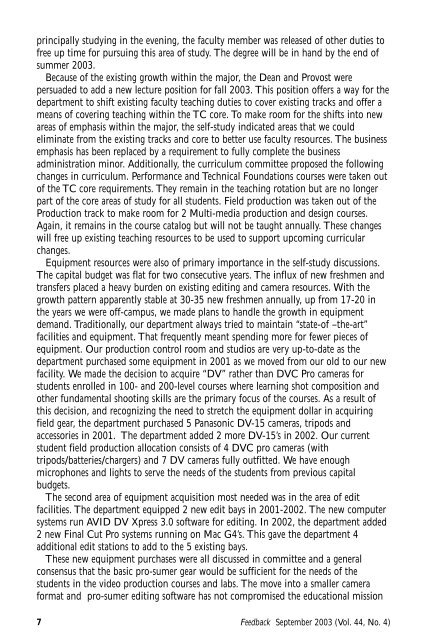PLANNING FOR GROWTH IN YEARS OF RESTRICTED RESOURCES
Feedback September 2003 - Broadcast Education Association
Feedback September 2003 - Broadcast Education Association
Create successful ePaper yourself
Turn your PDF publications into a flip-book with our unique Google optimized e-Paper software.
principally studying in the evening, the faculty member was released of other duties tofree up time for pursuing this area of study. The degree will be in hand by the end ofsummer 2003.Because of the existing growth within the major, the Dean and Provost werepersuaded to add a new lecture position for fall 2003. This position offers a way for thedepartment to shift existing faculty teaching duties to cover existing tracks and offer ameans of covering teaching within the TC core. To make room for the shifts into newareas of emphasis within the major, the self-study indicated areas that we couldeliminate from the existing tracks and core to better use faculty resources. The businessemphasis has been replaced by a requirement to fully complete the businessadministration minor. Additionally, the curriculum committee proposed the followingchanges in curriculum. Performance and Technical Foundations courses were taken outof the TC core requirements. They remain in the teaching rotation but are no longerpart of the core areas of study for all students. Field production was taken out of theProduction track to make room for 2 Multi-media production and design courses.Again, it remains in the course catalog but will not be taught annually. These changeswill free up existing teaching resources to be used to support upcoming curricularchanges.Equipment resources were also of primary importance in the self-study discussions.The capital budget was flat for two consecutive years. The influx of new freshmen andtransfers placed a heavy burden on existing editing and camera resources. With thegrowth pattern apparently stable at 30-35 new freshmen annually, up from 17-20 inthe years we were off-campus, we made plans to handle the growth in equipmentdemand. Traditionally, our department always tried to maintain “state-of –the-art”facilities and equipment. That frequently meant spending more for fewer pieces ofequipment. Our production control room and studios are very up-to-date as thedepartment purchased some equipment in 2001 as we moved from our old to our newfacility. We made the decision to acquire “DV” rather than DVC Pro cameras forstudents enrolled in 100- and 200-level courses where learning shot composition andother fundamental shooting skills are the primary focus of the courses. As a result ofthis decision, and recognizing the need to stretch the equipment dollar in acquiringfield gear, the department purchased 5 Panasonic DV-15 cameras, tripods andaccessories in 2001. The department added 2 more DV-15’s in 2002. Our currentstudent field production allocation consists of 4 DVC pro cameras (withtripods/batteries/chargers) and 7 DV cameras fully outfitted. We have enoughmicrophones and lights to serve the needs of the students from previous capitalbudgets.The second area of equipment acquisition most needed was in the area of editfacilities. The department equipped 2 new edit bays in 2001-2002. The new computersystems run AVID DV Xpress 3.0 software for editing. In 2002, the department added2 new Final Cut Pro systems running on Mac G4’s. This gave the department 4additional edit stations to add to the 5 existing bays.These new equipment purchases were all discussed in committee and a generalconsensus that the basic pro-sumer gear would be sufficient for the needs of thestudents in the video production courses and labs. The move into a smaller cameraformat and pro-sumer editing software has not compromised the educational mission7Feedback September 2003 (Vol. 44, No. 4)
















